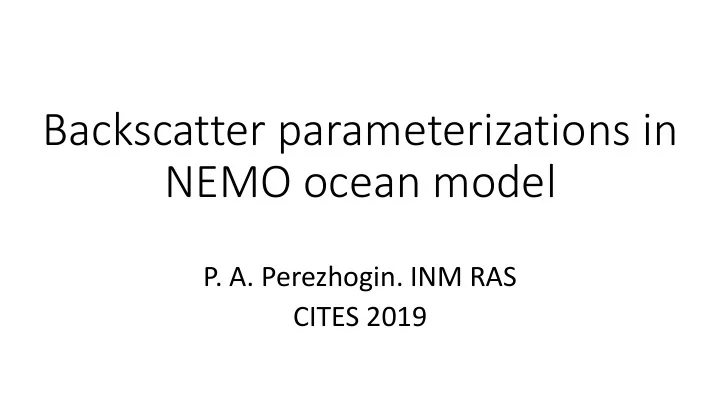

Backscatter parameterizations in NEMO ocean model P. A. Perezhogin. INM RAS CITES 2019
Motivation • Mesoscale eddies are badly resolved in climate ocean models • Consequently, eddy activity is damped • It leads to wrong eddy fluxes and mean state • Eddy activity can be amplified using backscatter parameterizations
Kinetic energy backscatter (KEB) • KEB is a process of energy flux from unresolved to resolved turbulence motions • KEB is opposite to turbulent viscosity • KEB can be estimated using high resolution model • Contrary to 3D turbulence, in 2D backscatter is much stronger due to the inverse direction of energy cascade • Energetically consistent backscatter is calibrated together with turbulent viscosity based on the fact: in 2D turbulence total energy exchange of unresolved and resolved scales is zero
Double Gyre configuration of NEMO primitive equation model 𝑒𝑈 𝑒𝑢 = 0, 𝑒𝑇 𝑒𝑢 = 0 𝜖𝑽 ℎ 𝜖𝑢 + 𝐛𝐞𝒘 ℎ + 𝐝𝐩𝒔 ℎ = − 1 𝛼 ℎ 𝑞 𝜍 0 𝜖𝑞 𝜖𝑨 = −𝜍 𝛼 ⋅ 𝑽 = 0 𝜖𝜃 𝜖𝑢 = −𝛼 ℎ ⋅ 𝐼 + 𝜃 𝑽 ℎ 𝜍 = 𝜍 0 (1 − 𝑏 𝑈 − 𝑈 0 + 𝑐(𝑇 − 𝑇 0 )) 𝑈, 𝑇, 𝑽, 𝑽 ℎ , 𝑽 ℎ , 𝑞, 𝜃, 𝜍, 𝐼 – potential temperature; salinity; velocity; horizontal velocity; vertically-averaged horizontal velocity; pressure; surface elevation; density; depth.
Double Gyre parameters • 3180 𝑙𝑛 × 2120 𝑙𝑛 × 4𝑙𝑛 • Box is rotated 45 𝑝 to zonal direction • Beta-plane approximation • Free-slip boundaries, quadratic bottom drag • Surface forcings: Zonal wind Atmospheric heat flux Fresh water flux Solar radiation
Model spin-up R1 R1 R4 R4 R9 R9 30 × 20 × 30 120 × 80 × 30 270 × 180 × 30 𝑜 𝑦 × 𝑜 𝑧 × 𝑜 𝑨 1 0 , 106 𝑙𝑛 1/4 0 , 26.5 𝑙𝑛 1/9 0 , 11.7 𝑙𝑛 mesh step Non-eddy-resolving Eddy-permitting Eddy-resolving • 1000 years R1 model • Then 100 years R4 and R9
Relative vorticity snapshots at different resolutions 1 𝑝 1/4 𝑝 1/9 𝑝 1/27 𝑝
Vorticity Temperature
Eddy flux in depth Meridional heat flux, R9 Mean flux Full flux Eddy flux
R4 eddy flux R9 eddy flux
Eddy heat flux models Viscosity reduction in R4 Viscosity reduction
ሶ ሶ ሶ Negative viscosity backscatter (Jansen 2015) • “Energetically consistent” – zero energy exchange with unresolved scales • Energy returning using Laplace operator with negative viscosity • Viscosity varies in space and time 𝜉 2 𝑦, 𝑧, 𝑨, 𝑢 • Additional equation for subgrid energy 𝑓(𝑦, 𝑧, 𝑨, 𝑢) 𝜖𝑽 ℎ 2 𝑽 ℎ + 𝛼 ℎ 𝜉 2 𝛼 ℎ 𝑽 ℎ 𝜖𝑢 = ⋯ + 𝜉 4 Δ ℎ 𝜉 4 = 𝑑𝑝𝑜𝑡𝑢 < 0, 𝜉 2 ≤ 0 𝐹 𝑒𝑗𝑡𝑡 = 𝜉 4 𝛼 ℎ 𝑽 ℎ ⋅ 𝛼 ℎ (Δ ℎ 𝑽 ℎ ) 𝜉 2 = −Δ𝑦 ⋅ 𝑑 𝑐𝑏𝑑𝑙 max(𝑓, 0) 𝑒𝑓 𝐹 𝑐𝑏𝑑𝑙 = 𝜉 2 𝛼 ℎ 𝑽 ℎ ⋅ 𝛼 ℎ 𝑽 ℎ 𝐹 𝑒𝑗𝑡𝑡 + ሶ 𝑒𝑢 = 𝐹 𝑐𝑏𝑑𝑙 + 𝜉 𝑓 Δ𝑓
ሶ Stochastic backscatter (Grooms, Majda2017; Berner2009) • 𝜔 𝑦, 𝑧, 𝑨 = 𝜚 𝑦, 𝑧 ⋅ max 𝐹 𝑒𝑗𝑡𝑡 , 0 • 𝜚(𝑦, 𝑧) – white noise in space and time, 𝑂(0,1) 𝜖𝑉 ℎ 𝜖𝑢 = ⋯ + 𝛽𝛼 ⊥ 𝜔, Where (⋅) - 6 applications of Laplace filter nullifying chess-noise • Condition on amplitude 𝛽 representing global energy balance: 𝛽 2 Δ𝑢 2 𝑒𝑊 = න ሶ න 𝛼 ⊥ 𝜔 𝐹 𝑒𝑗𝑡𝑡 𝑒𝑊 2
Eddy kinetic energy (EKE) in colour, SST in contours
Eddy heat flux in colour, MOC in contours Ψ 𝑁𝑃𝐷 𝑧, 𝑨 = −𝑨 න න 𝑊(𝑦, 𝑧, 𝑨)𝑒𝑦𝑒𝑨′ −𝐼
Time spectra averaged over the black rectangle
Errors in mean state max 𝜚 𝑆4 − 𝜚 𝑆9 and mean 𝜚 𝑆4 − 𝜚 𝑆9 R4 R4 negative viscosity R4 stochastic SST, 𝐷 𝑝 7.04 0.37 3.00 0.28 4.33 0.27 SSH, m 0.707 0.063 0.378 0.038 0.419 0.040
The main drawback – maximum energy exchange near the boundary
Conclusions • Backscatter can amplify mesoscale eddies • Improvements are seen in mean fields (SST, SSH, MOC), in variability (EKE, time spectra) and in cross-correlation (eddy heat flux) • Stochastic and negative viscosity KEBs are qualitatively similar
Relative vorticity snapshots at different resolutions 1/4 𝑝 + neg.visc 1 𝑝 1/4 𝑝 1/9 𝑝 1/27 𝑝
Recommend
More recommend